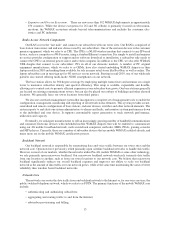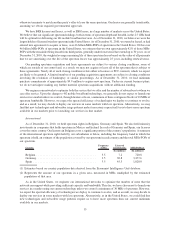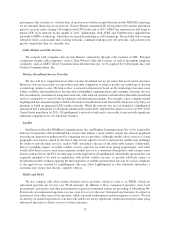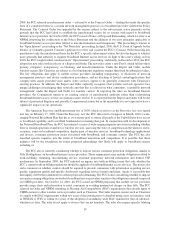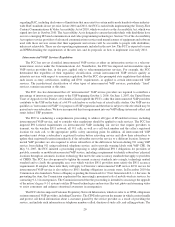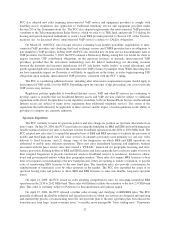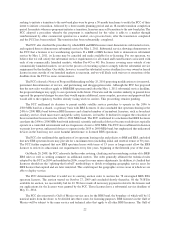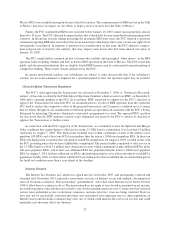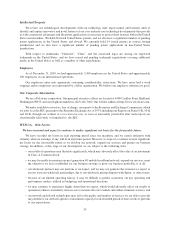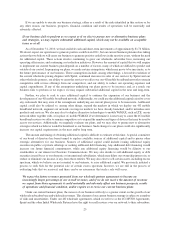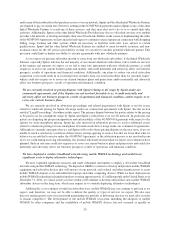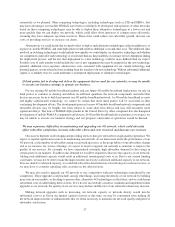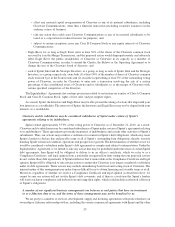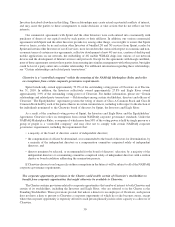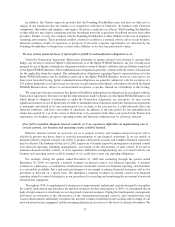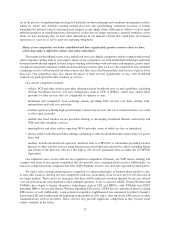Clearwire 2010 Annual Report Download - page 27
Download and view the complete annual report
Please find page 27 of the 2010 Clearwire annual report below. You can navigate through the pages in the report by either clicking on the pages listed below, or by using the keyword search tool below to find specific information within the annual report.seeking to initiate a transition to the new band plan were be given a 30-month timeframe to notify the FCC of their
intent to initiate a transition, followed by a three-month planning period and an 18-month transition completion
period. In markets where no proponent initiates a transition, licensees may self-transition to the new band plan. The
FCC adopted a procedure whereby the proponent is reimbursed for the value it adds to a market through
reimbursement by other commercial operators in a market, on a pro-rata basis, after the transition is completed
and the FCC has been notified. The transition has been substantially completed.
The FCC also clarified the procedure by which BRS and EBS licensees must demonstrate substantial service,
and required them to demonstrate substantial service by May 1, 2011. Substantial service showings demonstrate to
the FCC that a licensee is not warehousing spectrum. If a BRS or EBS licensee fails to demonstrate substantial
service by May 1, 2011, its license may be canceled and made available for re-licensing. For our spectrum, we
believe that we will satisfy the substantial service requirements for all owned and leased licenses associated with
each of our commercially launched markets, whether Pre-4G or 4G. For licenses covering areas outside of our
commercially launched markets, we are in the process of executing a plan to comply with the substantial service
requirement by the deadline. Our ability, however, to meet the substantial service deadline for every owned or leased
license in areas outside of our launched markets is uncertain, and we will likely seek waivers or extensions of the
deadline from the FCC in some circumstances.
The FCC released a Notice of Proposed Rulemaking on May 25, 2010 proposing modifications to its renewal,
permanent discontinuance of service, and partitioning and disaggregation rules. Although the FCC has proposed
that the new rules would not apply to BRS/EBS spectrum until after the May 1, 2011 substantial service deadline,
the proposed changes may apply to our operations in the future. Clearwire and the wireless industry in general have
opposed the proposed changes because they would require additional, more complex, processes and paperwork that
would add to the regulatory burdens already facing wireless carriers. This proceeding remains pending.
The FCC reaffirmed its decision to permit mobile satellite service providers to operate in the 2496 to
2500 MHz band on a shared, co-primary basis with BRS licensees. It also concluded that spectrum sharing in the
2496 to 2500 MHz band between BRS licensees and a limited number of incumbent licensees, such as broadcast
auxiliary service, fixed microwave and public safety licensees, is feasible. It declined to require the relocation of
those incumbent licensees in the 2496 to 2500 MHz band. The FCC reaffirmed its conclusion that BRS licensees
can share the 2496 to 2500 MHz band with industrial, scientific and medical devices because such devices typically
operate in a controlled environment and use frequencies closer to 2450 MHz. The FCC also reaffirmed its decision
to permit low-power, unlicensed devices to operate in the 2655 to 2690 MHz band, but emphasized that unlicensed
devices in the band may not cause harmful interference to licensed BRS operations.
The FCC also reaffirmed the application of its spectrum leasing rules and policies to BRS and EBS, and ruled
that new EBS spectrum leases may provide for a maximum term (including initial and renewal terms) of 30 years.
The FCC further required that new EBS spectrum leases with terms of 15 years or longer must allow the EBS
licensee to review its educational use requirements every five years, beginning at the fifteenth year of the lease.
On March 20, 2008, the FCC released a further order revising, clarifying and reconsidering certain of its BRS/
EBS rules as well as seeking comment on additional matters. The order generally affirmed the technical rules
adopted by the FCC in 2004 and modified in 2006, except for some minor adjustments. In addition, it clarified that
licensees should use the “splitting-the-football” methodology to divide overlapping geographic service areas for
EBS licenses that expired and are later reinstated. This could impact the geographic service areas in which we are
able to deploy service.
The FCC determined that it would use its existing auction rules to auction the 78 unassigned BRS BTA
spectrum licenses. The auction started on October 27, 2009 and concluded shortly thereafter. Of the 78 BTAs
available for auction, we successfully bid for 42. We have made all necessary payments related to the licenses and
our applications for the licenses were granted by the FCC. These licenses have a substantial service deadline of
May 11, 2014.
The FCC also reinstated a Gulf of Mexico service area for the BRS band, the boundary of which will be 12
nautical miles from the shore, to be divided into three zones for licensing purposes. BRS licensees in the Gulf of
Mexico will be subject to the same service and technical rules that apply to all other BRS licensees. The Gulf of
22



